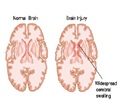
The prototype system, called "NeuroTouch," uses 3-D graphics and haptic (sense of touch) technology to provide a realistic look and feel for practice in performing common tasks in brain cancer surgery. Lead author Sébastien Delorme, PhD, of the National Research Council Canada and colleagues believe the NeuroTouch system could enhance "acquisition and assessment of technical skills" for neurosurgeons in training.
System Simulates Common Neurosurgery Tasks and ToolsThe NeuroTouch system was developed by a team of more than 50 experts from the National Research Council Canada, with input from surgeons at more than 20 Canadian teaching hospitals. The goal was to design a simulation system to provide neurosurgical trainees with opportunities to practice basic surgical skills.
The NeuroTouch software produces 3-D graphics, simulating what the neurosurgeon sees through the operating microscope during surgery—including detailed, lifelike renderings of brain tissue, blood vessels, and tumors. The system also includes haptic tool manipulators, providing tactile feedback similar to what the surgeon would feel during surgery. The simulator runs on computers that, while powerful, are similar to those used to run popular games.
The researchers designed training tasks to simulate common neurosurgery procedures using the NeuroTouch. In one task, the surgeon is to remove brain tumor while leaving normal tissues intact, using two different suction devices. In this simulation, the system provides touch and visual cues to discriminate between healthy tissue and brain tumor.
In the other task, the surgeon must remove a vascularized (supplied with blood) tumor while controlling blood loss. The blood vessels and tissues look realistic, including normal pulsations. The vessels bleed when the surgeon applies a cutting tool and stop bleeding when he or she uses a simulated cautery tool.
Advertisement
During the development process, the researchers received feedback through an advisory network of teaching hospitals. The 3-D visual graphics received high praise, although the tactile feedback system came in for more criticism. Surgeons testing the system also suggested improvements to the ergonomics of using the simulator.
Advertisement
Medical simulators—similar to those used to train airline pilots—are increasingly viewed as a cost-effective complement to traditional surgical training. For example, a commercially available simulator has proven effective in helping trainees perform minimally invasive gallbladder surgery more rapidly, with a lower risk of patient injury.
The NeuroTouch system appears to be a promising tool for extending virtual reality technology to teaching common and important neurosurgery techniques. While it is not the first neurosurgical simulator, it provides key advances over previous systems, particularly in terms of providing real-time graphics and tactile feedback.
The next step will be to evaluate the new system in actual neurosurgical training programs. "First generation NeuroTouch prototypes have been set up in 7 teaching hospitals across Canada, to be used for beta testing and validation and evaluated for integration in a neurosurgery training curriculum," according to Dr. Delorme and colleagues, and a new generation of NeuroTouch simulators is currently being deployed worldwide.
Source-Eurekalert















